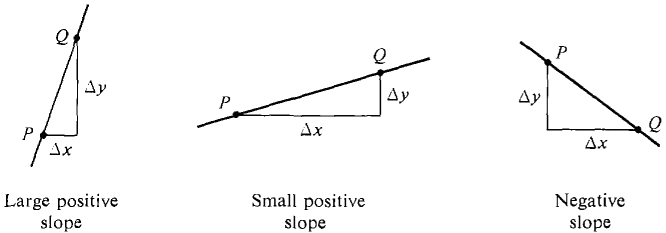| The ebook Elementary Calculus is based on material originally written by H.J. Keisler. For more information please read the copyright pages. |

|

Home  Real and Hyperreal Numbers Real and Hyperreal Numbers  Straight Lines Straight Lines  Theorem 1: Slope Of a Line Theorem 1: Slope Of a Line |
|






|
|
Theorem 1: Slope Of a Line
THEOREM 1 Suppose a line L passes through two distinct points P(x1,y1) and Q(x2,y2). If x1 = x2, then the line L is vertical. If x1 ≠ x2, then the slope of the line L is equal to the change in y divided by the change in x,
PROOF Suppose x1 ≠ x2, so L is not vertical. Let m be the slope of L. L has the point-slope formula y - y1 = m(x - x1). Substituting y2 for y and x2 for x, we see that m = (y2 - y1)/(x2 - x1). Theorem 1 shows why the slope of a line is a measure of its direction. Sometimes Δx is called the run and Δy the rise. Thus the slope is equal to the rise divided by the run. A large positive slope means that the line is rising steeply to the right, and a small positive slope means the line rises slowly to the right. A negative slope means that the line goes downward to the right. These cases are illustrated in Figure 1.3.4.
Figure 1.3.4 There is exactly one line L passing through two distinct points P(x1,y2) and Q(x2, y2). If x1 ≠ x2, we see from Theorem 1 that L has the equation
This is called the two-point equation for the line.
|
|
Home  Real and Hyperreal Numbers Real and Hyperreal Numbers  Straight Lines Straight Lines  Theorem 1: Slope Of a Line Theorem 1: Slope Of a Line |
|
Last Update: 2010-11-25




